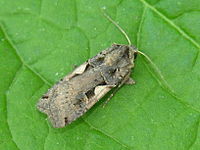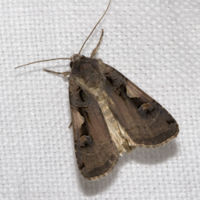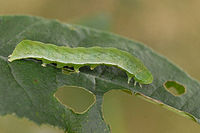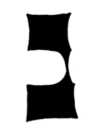- Setaceous Hebrew Character
-
Setaceous Hebrew Character 

Scientific classification Kingdom: Animalia Phylum: Arthropoda Class: Insecta Order: Lepidoptera Family: Noctuidae Genus: Xestia Species: X. c-nigrum Binomial name Xestia c-nigrum
(Linnaeus, 1758)Synonyms - Megasema c-nigrum (Linnaeus, 1758)
- Phalaena c-nigrum Linnaeus, 1758
- Bombyx gothica var. nunatrum Esper, 1786
- Bombyx gothica var. singularis Esper, 1786
- Agrotis degenerata Staudinger, 1889
- Agrotis suffusa Tutt, 1892
- Agrotis rosea Tutt, 1892
- Agrotis umbrata Schultz, 1908
- Agrotis fritschi Culot, 1910
- Agrotis c-nigrum var. depravata Bang-Haas, 1912
- Agrotis nigrescens Buresch, 1914
- Agrotis maerens Dannehl, 1925
- Agrotis c-nigrum var. kurilana Bryk, 1942
- Amathes c-nigrum ignorata Eitschberger, 1972
- Xestia adela Franclemont, 1980
The Setaceous Hebrew Character (Xestia c-nigrum) is a moth of the family Noctuidae. It is found in the Palearctic ecozone. It is a common species throughout Europe. It is also found in North America, from coast to coast across Canada and the northern United States to western Alaska. It occurs in the Rocky Mountains from Montana to southern Arizona and New Mexico. In the east it ranges from Maine to North Carolina. It has recently been recorded from Tennessee.
The forewings of this species are reddish brown with distinctive patterning towards the base: a black mark resembling the Hebrew letter Nun (נ) with a pale cream-coloured area adjacent to this mark. The hindwings are cream coloured. The wingspan is 35-45 mm. Two broods are produced each year and the adults are on the wing between May and October.[1] This moth flies at night and is attracted to light and sugar as well as flowers such as Buddleia, ivy and ragwort.
The larva is pale brown or green with black spots. It feeds on a huge variety of plants (see list below). The species overwinters as a larva.
Recorded food plants
- Acer - Maple
- Allium - Onion
- Apium - Celery
- Avena - Oat
- Beta - Beet
- Brassica
- Calendula - Marigold
- Chrysanthemum
- Cichorium - Chicory
- Cirsium - Creeping Thistle
- Comptonia - Sweetfern
- Daucus - Carrot
- Epilobium - Rosebay Willowherb
- Helianthus
- Hordeum - Barley
- Hypericum - St John's Wort
- Lactuca - Lettuce
- Lamium - Dead-nettle
- Lantana
- Linum
- Lobelia
- Lycopersicon - Tomato
- Malus - Apple
- Medicago - Alfalfa
- Myosotis - Forget-me-not
- Nicotiana - Tobacco
- Photinia
- Pisum - Pea
- Plantago - Plantain
- Platanus - Oriental Plane
- Primula
- Pyrus - Pear
- Rheum - Rhubarb
- Ribes - Currant
- Rumex
- Senecio - Groundsel
- Solanum - Potato
- Solidago - Goldenrod
- Spiraea
- Stellaria - Chickweed
- Taraxacum - Dandelion
- Thalictrum - Meadow-rue
- Trifolium - Clover
- Triticum - Wheat
- Urtica - Nettle
- Vaccinium
- Veratrum
- Viburnum
- Viola
- Vitis - Grape
- Zea - Maize
References
- ^ The flight season refers to the British Isles. This may vary in other parts of the range.
- Chinery, Michael. Collins Guide to the Insects of Britain and Western Europe 1986 (Reprinted 1991)
- Skinner, Bernard. Colour Identification Guide to Moths of the British Isles 1984
External links
Categories:- Xestia
- Animals described in 1758
Wikimedia Foundation. 2010.


